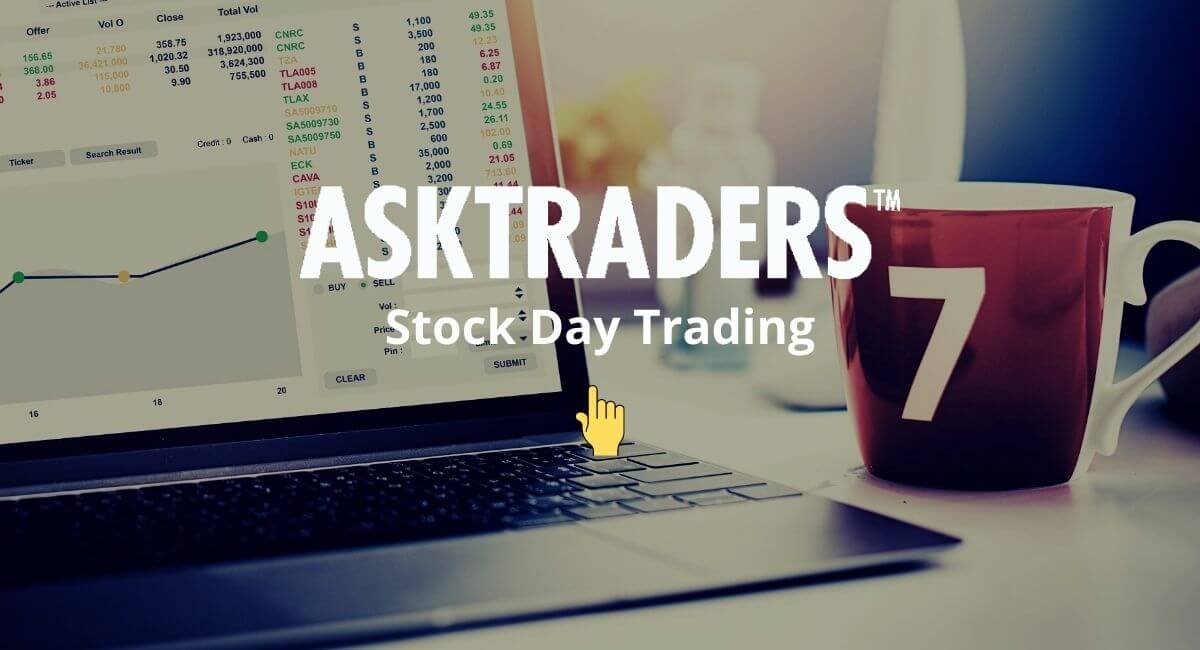Day trading in any instrument is not an easy path to take, and stocks is no different. You will rely on volatility in the asset you trade, and usually some catalyst that you can trade off the back of, ideally with some market ‘alpha'.
Day trading stocks often relies on trying to use the advantage of knowledge, either of an individual stock, or of a broader economic factor that may impact the wider stock market, and in turn the company you are day trading. There are many others that will trade using technical analysis, and indicators to spot good entries and exits.
Whichever method suits you best is a matter of personal preference, and strategy. Here we will cover some of the basics of day trading stocks to get started.
YOUR CAPITAL IS AT RISK

Table of contents
What is Day Trading and How Can You Get Started?
Short-term trading, also known as day trading strategy or day trading, is the purchase and sale of stocks in less than 24 hours. Day traders will be quite active, and might trade dozens of times in a single day.
Day trading gives the trader more control over the trades they open because they are not subject to overnight charges. Day traders typically keep a close eye on market movements. According to the system they install, they will act quickly if something is profitable or potentially profitable. This is because they will be able to concentrate on a higher winning percentage in their trades.
Your trading environment must be supported by robust tools if you want to day trade successfully. Among the fundamental requirements are:
- Durable Computer
- Large Monitor
- Fast internet connection
How Does Day Trading Work?
Day traders can trade the market five days a week (with the exception of cryptocurrency, which is traded 24 hours a day, seven days a week). The opening hours of the Stock Exchange are given special attention because the majority of traders are present, and the trading volume is very high. Day trading can be considered a regular job, but it does not provide a steady income if done as a hobby.
Some traders prefer to trade for a few seconds and others for a few hours, depending on their own strategy, and areas where they feel there is some ‘alpha' or advantage on the market. Traders are always subject to market conditions as you cannot make a successful trade if there is no movement. The market's high volatility (movement) is something that many traders will look for, quite different then from a long term investor who would be looking for a secure entry.
Stock Day Trading Basics

1. Equip Yourself with Enough Information
Daily trading is typically performed by traders who have prior experience and a thorough understanding of the market's fundamentals. Many people advise new traders to refrain from doing it. However, if you are interested, you should arm yourself with significant knowledge.
These fundamentals include procedures, trading tools, in-depth knowledge of the products to be traded, and market conditions. Find out what factors can affect the price as well.
2. Profit from Long-Term Trends
Checking long-term trends is one method many day traders employ. The long-term trend is usually in the 1 to 4-hour time frame. They enter the market to open a position after determining the direction of the trend. The most common time frame is 10 to 15 minutes. The strategy of detecting this trend is also referred to as trend trading.
3. Utilise Counter Trend Trading
Not all day traders base their daily trading decisions on long-term trends. Some traders prefer to open positions in the opposite direction. This is done so that they can enter the market earlier if the trend changes. This strategy, like the long-term trend, can make use of a time frame with a duration of 10 to 15 minutes.
4. Take Note of the Margin
Margin trading is the practice of trading assets using funds obtained from securities firms as third parties. When using margin trading, you are trading using money that does not belong to you. That is, there are some risks you must be willing to accept.
Margin trading is not recommended for beginners, even though it can aid in trading. The reason for this is that there is a chance that you will mishandle the situation, resulting in massive losses.
5. Specify Exit and Entry Times
The correct entry and exit times determine your level of day trading success. As a result, carefully consider when to enter and when to exit, as well as the price level at which you will exit. You can avoid trading blunders this way. If you notice less favourable market conditions, it is a good idea to exit as soon as possible to minimise losses.
6. Limit the Capital You Use
For starters, when it comes to day trading, you should not go all in. Begin your trading with low-value stocks or foreign currencies. You can choose a maximum of two stocks for your portfolio. You can learn to track and look for profit opportunities more easily with a small investment. Using a large number of stocks or foreign currencies when you do not understand market conditions makes it difficult to exit at the appropriate time.
How to Choose Stocks to Day Trade

Liquidity
This is most likely the most important characteristic of the best stocks for intraday trading. Liquid stocks are traded in large quantities, allowing for larger purchases and sales without affecting the price. And, because intraday trading strategies frequently rely on speed and precise timing, you never want to be left without a market for your stock at the end of the day.
Moderate Volatility
Most traders avoid highly volatile stocks, which are those whose prices fluctuate violently and/or in unpredictable ways, with prices fluctuating more than 5% on a typical day. Instead, they stick to equities that move at a more moderate pace – you want the stew to boil, but not boil – and, in fact, make their money from small price changes rather than large ones. Stocks that are highly volatile tend to be somewhat liquid as well.
Group Followers
While some traders specialise in contrarian drama, the majority of traders seek equities that move in relation to their sector and index group. This means that when an index or sector rises, so does the price of an individual stock. These equities are more reliable and predictable in their movements because they follow the expected path in their industry or category, making it easier for you to move yours.
Best Stocks for Day Trading
This will depend a lot on you, but most day traders of stocks will want those with volatility, and ideally stick to a select bunch of names that you will know inside out. The earnings releases, the executive changes, the forward outlook, market expectations, analyst targets, and general sector sentiment will all be things you will want to know inside out.
Then you have the technical analysis aspects of support and resistance, how the stock moves through different parts of the day as various markets open/close, as well as being able to spot movements in the chart that are just outside of the ordinary.
All these factors and knowledge areas will only come through consistently following a stock, understanding how it functions normally, and looking for abnormal movement that you can capitalise from. You will not get that from the whole market, so when you are looking for the best stocks for day trading, they will be the ones you know most about, and are most comfortable in understanding everything you need to. For us, the below are 3 top stocks that we like to follow:
Etsy Inc.
Etsy Inc.'s stock price, like many others, surged during the pandemic. This indicates that the stock's price movements are volatile, with more profitable swing trading opportunities.
NIO
Another best stock for day trading is NIO, a Chinese multinational vehicle manufacturer. While the company’s shares are significantly below its pandemic highs, it, the stock is highly traded and liquid, making it a good candidate for day trading.
Tesla Inc.
Lastly, Tesla Inc. is another popular choice for day traders because of the organisation’s major proponent of environmental conservation. Again, it is another stock that hasn’t performed well lately and is highly liquid. As a result, it provides many opportunities to trade each day.
Risks of Day Trading
If you trade incorrectly, day trading can be pretty dangerous. Despite the fact that the requirement to make additional contributions to CFD trading has been removed, there is still the possibility of losing a significant amount of cash. As a result, when placing positions, select a reasonable position size. Many beginners, in particular, take too big a risk.
You should definitely use an automatic loss limit to protect your position (stop loss). This tool closes a position at a predetermined price or loss. The trader can always limit risk. In the end, the trader is the one who determines the risk. It is entirely up to him how much money he wishes to invest in the market.
Create a trading strategy and set goals on a regular basis. In this regard, good risk management can be extremely beneficial. Professional investors put 1-2 percent of their total capital at risk in each position.
Why Day Trade Stocks?

As with any other trading style, there are advantages and disadvantages. In general, many traders are enthralled by the prospect of exchanging their own work for stock exchange trading. Simply spend your working hours in front of a computer to earn enticing money.
Profits are also realised quickly, which is an advantage. While longer-term investments may yield a few percent per month, a day trader earns his daily percentage. He also saves on swap costs (financing costs, interest) for leveraged derivatives, which accrue overnight. However, because of the high frequency of day trading trades, trading fees are generally higher.
| Pros | Cons |
|---|---|
| Quick gains possible | Higher trading volume means higher trading fees as well |
| No overnight trading fees (swaps, interest payments) | You will need very fast reactions and high brain capacity |
| It is not always necessary to sit for many hours in front of a computer because the goal can be achieved quickly | Trade with very fast algorithms and professional traders |
Conclusion : Not An Easy Path, But One That Continues To Allure
Day trading is a legitimate way to enter the market semi-professionally, or at least with designated goals in mind. However, one should not approach this subject lightly. It can take several years for a trader to become profitable and knowledgeable enough to sustain portfolio growth. We can assure you that it will not work unless you put forth your own effort.
You may still have the best method for the market in front of you, but you must practise on a regular basis and understand how the market behaves at various points. You can make money even with the most basic items on the market. However, trading requires more than just the right strategy.
As a day trader, it is critical that you understand and practise the proper day trading strategies in order to have a successful trading journey. A successful day trader makes certain that they do not lose money recklessly, even if they are trading in small amounts, as this can be costly if it occurs frequently.










